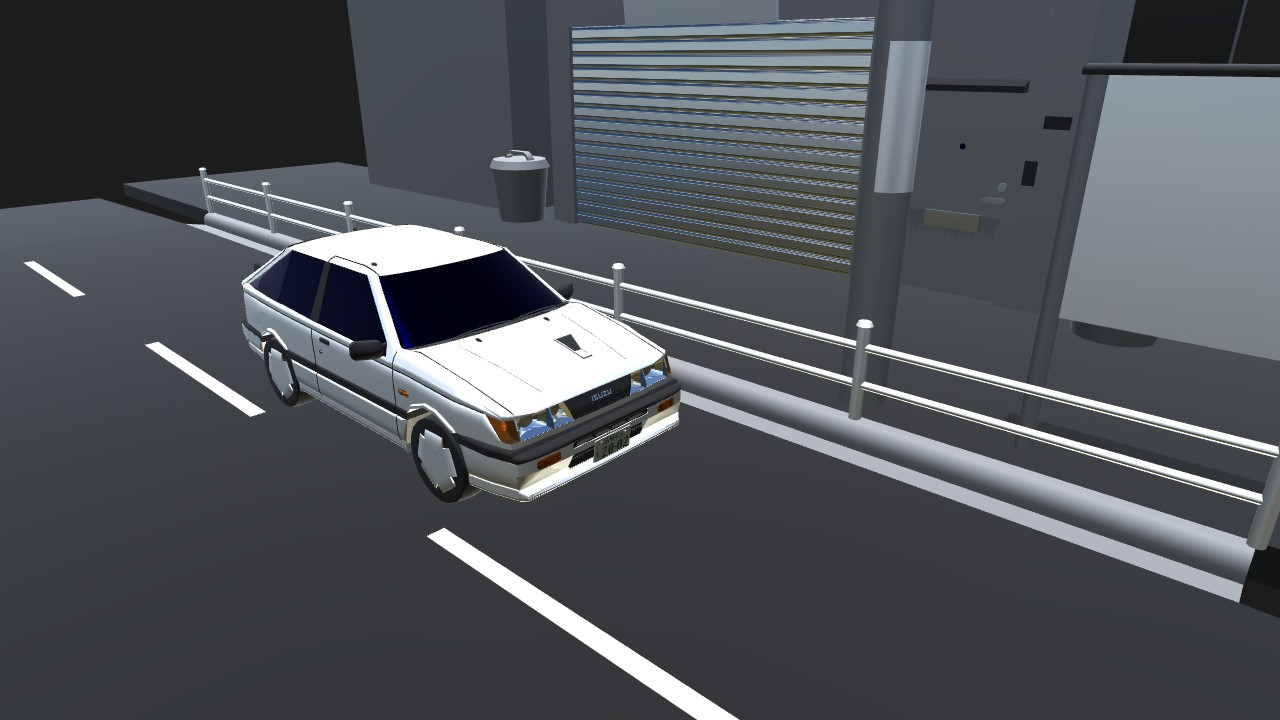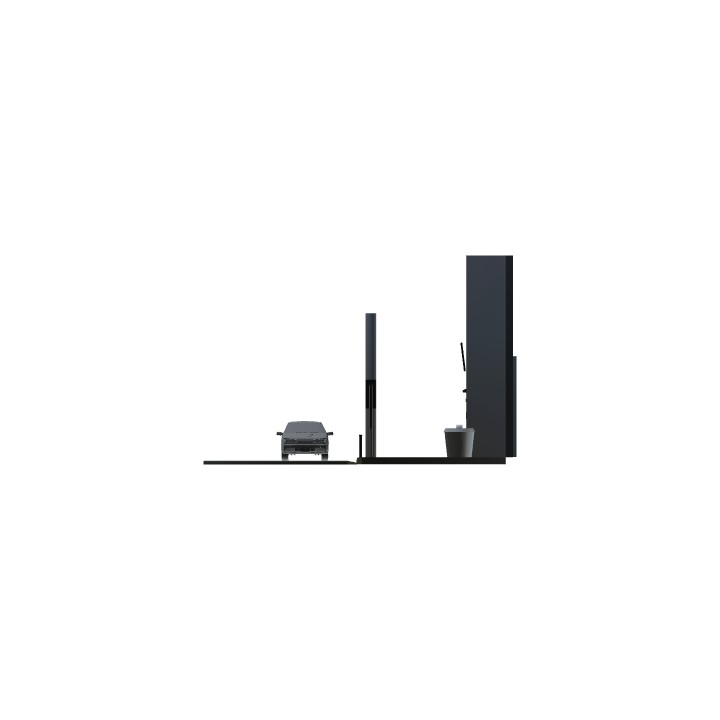
Please enjoy!
Video


Control
AG5:Gyro
Trim down: Hazard lamp




Wiki
The Isuzu Gemini was a subcompact car that was produced by the Japanese automaker Isuzu from 1974 to 2000. The same basic product was built and/or sold under several other names, sometimes by other General Motors brands, in various markets around the world. While the first generation was of a rear-wheel drive design, later versions were all front-wheel-drive.
General Motors sought a replacement for their world car T-body Kadett / Gemini, and this time, instead of building one design on several continents, they decided to build a world car in one location and export it to several continents. As a considerable portion of the T-body manufacturing had been turned over to Isuzu in Japan for economic reasons, so would the manufacturing of the replacement. In 1984, Isuzu again commissioned Giorgetto Giugiaro who was responsible for the 117 Coupé and the Piazza. This time, he was to design an economy car on the new front-wheel drive R-body platform. The R-body featured a MacPherson strut front suspension and beam axle rear suspension, which foreshadowed most of GM's offerings through their current model lineup. Giugiaro's design followed the Piazza design very closely in shape and detail, though the proportions made the Gemini appear shorter and taller in its three-door version, and a four-door sedan (notch back) was also designed.
Unfortunately for everyone involved, Isuzu presented the designs to GM prior to freezing them, and GM ordered a number of detail changes to them without ever consulting the designer, Giugiaro, which was taken as an insult, and ended the long relationship between the noted Italian designer and Japan's second oldest car builder. The insult was serious enough to Giugiaro that he denied the design was his until a decade after the vehicle went out of production.
The R-body Gemini was introduced in May 1985 as the Gemini FF (after it had already gone on sale as a Chevrolet in the United States), with an all-new line of engines. In Japan, originally with chassis code JT150, it was available with a carburetted 1.5-liter SOHC engine. An also newly developed 1.5-liter inline four diesel engine (JT600) was added to the lineup in November. At the other end of the lineup, a 120 PS (88 kW) fuel-injected and turbocharged version of the 1.5-liter 4XB1 engine ("Irmscher") was added in May 1986. Originally, the transmission started out with a choice of a 5-speed manual or a 3-speed automatic, but NAVi5, an automated manual transmission, was added in 1986.
The FF Gemini underwent a facelift in February 1987, receiving a more aggressive front styling with wraparound headlight as well as other minor changes. At the same time the "FF" moniker was dropped, as parallel production of the preceding RWD Gemini came to an end. In March 1987 the Gemini saw its European premier, at the Geneva Salon. European sales of the already somewhat dated Gemini were disappointing, and Isuzu soon withdrew from the European passenger car market entirely.
A 1.6-liter DOHC engine with 135 PS (99 kW) was introduced in February 1988. Export versions were also available with a smaller 1.3-liter four to suit taxation systems based on displacement.[15] This offered 72 PS (53 kW), while export specification 1.5s had 76 PS (56 kW) on tap and the naturally aspirated diesel offered 52 PS (38 kW) outside Japan.[16] Trim levels were widely varied, from basic models ("C/C" in Japan, "LT" in general export markets, and "S" in the US) to Irmscher, ZZ, and Lotus Tuned versions, and plenty of optional equipment and dealer options were available.
North America
In the US, the vehicle was available from Chevrolet (and later Geo) as the Spectrum, or from Isuzu themselves, as the I-Mark. GM's Pontiac division sold the I-Mark as the Pontiac Sunburst in Canada from 1985 to 1988. Sales were limited to coastal markets initially, as import quotas restricted the number of cars General Motors could sell in the United States.[17] The Spectrum was presented at the end of November 1984, with cars already on sale in 16 eastern states. Isuzu's own I-Mark went on sale during the 1985 model year.[18] Due to the quotas, only 29,500 cars were available the first model year, about a quarter of what GM had hoped to be able to sell.1985 and 1986 models featured a unique eggcrate grille flanked by single square sealed-beam headlights.
GM Canada announced that the Sunburst's replacement would be the Passport Optima in 1989. For GM, this was an entry level vehicle to attract young buyers and to compete with Japanese midsize cars in the US market. Chevrolet's Spectrum lacked many of the options and equipment of the I-Mark, although with the exception of a brief run of decontented hatchbacks in 1988 dubbed "Spectrum Express" they were not as austere as the base trim levels of contemporary Dodge Colt, Toyota Tercel and Honda Civics. Both were available with the 70 hp (52 kW) 1.5-liter SOHC non-turbo and 110 hp (82 kW) turbo engines, but neither diesel engines nor NAVi5 were offered in the US. The turbo model I-Mark was called the RS model in 1988 and then changed to the LS model in 1989. The I-Mark was available with the 125 hp (93 kW) 1.6-liter DOHC engine in 1989 only, as the RS model. In 1988 and 1989, the LS and RS models were offered with Lotus Tuned Suspension, the sportier suspension featuring more rigid dampers, alternate spring rates, and bigger sway bars.
The first and second generation Isuzu Geminis, specifically the diesel ones, were the most popular taxicab models in the Philippines in the 80s and early 90s. Models were phased out and gradually replaced with newer models from Toyota and Nissan.
The front-wheel drive Geminis (second and third generation) were marketed in Japan with the catch phrase "Shortstop of the streets" (Machi no yugekishu), and television commercials featuring exciting driving stunts throughout the streets of Paris. With French professional stunt driver Rèmy Julienne mostly coordinating with all of the stunts, the Geminis enjoyed wide popularity.
In detail
Specifications
Spotlights
- Feanor 5.6 years ago
- BaconAircraft 5.6 years ago
General Characteristics
- Predecessor ISUZU GEMINI Irmscher Turbo
- Created On iOS
- Wingspan 35.7ft (10.9m)
- Length 82.0ft (25.0m)
- Height 23.8ft (7.3m)
- Empty Weight N/A
- Loaded Weight 2,195lbs (995kg)
Performance
- Wing Loading 439,839.3lbs/ft2 (2,147,483.6kg/m2)
- Wing Area 0.0ft2 (0.0m2)
- Drag Points 0
Parts
- Number of Parts 693
- Control Surfaces 0
- Performance Cost 2,405







With your Custom building, it feels like in real world!
Lol
Gang car #1: if you see these, run